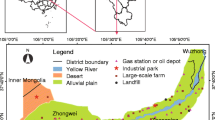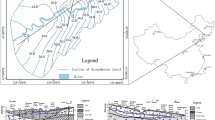Abstract
There is growing evidence of increasing pollution threats to groundwater caused by anthropogenic activities. Risk assessment has proven a useful tool for groundwater management, environmental planning, and decision making in numerous research projects. Based on the origin–pathway–target model, a quantitative evaluation model was established in this study. This study shows that most areas of Suzhou are under medium-to-very high vulnerability to organic pollution, for which the media of the aquifer and the depth of groundwater are responsible. The risk-assessment map shows that the very high-risk areas were mostly distributed in the southeast along with small areas on the northern bank of the river. However, on the groundwater value-weighted risk map, the very high-risk regions were concentrated in the north. Human activities in the industrial area strongly influenced the-risk of organic pollution to groundwater as the areas with very high risks were found mainly in the industrial area. Areas containing very high groundwater value and basic risk class generated a very high value-weighted groundwater contamination risk class. The result of the validation showed that this model was appropriate for groundwater risk assessment for organic pollution in this area. It should be noted that the value-weighted risk map was completely different from the one of the risk map.










Similar content being viewed by others
References
Al-Adamat RA, Foster ID, Baban SM (2003) Groundwater vulnerability and risk mapping for the Basaltic aquifer of the Azraq basin of Jordan using GIS, Remote sensing and DRASTIC. Appl Geogr 23(4):303–324
Alexander M (2000) Aging, bioavailability, and overestimation of risk from environmental pollutants. Environ Sci Technol 34(20):4259–4265
Aller L, Lehr JH, Petty R, Bennett T (1987) DRASTIC: a standardized system to evaluate groundwater pollution potential using hydrogeologic settings. National Water Well Association, Worthington, OH
Andreo B, Goldscheider N, Vadillo I, Vías JM, Neukum C, Sinreich M, Jiménez P, Brechenmacher J, Carrasco F, Hötzl H (2006) Karst groundwater protection: first application of a Pan-European Approach to vulnerability, hazard and risk mapping in the Sierra de Líbar (Southern Spain). Sci Total Environ 357(1):54–73
Arias-Estévez M, López-Periago E, Martínez-Carballo E, Simal-Gándara J, Mejuto JC, García-Río L (2008) The mobility and degradation of pesticides in soils and the pollution of groundwater resources. Agr Ecosyst Environ 123(4):247–260
Babiker IS, Mohamed MA, Hiyama T, Kato K (2005) A GIS-based DRASTIC model for assessing aquifer vulnerability in Kakamigahara Heights, Gifu Prefecture, central Japan. Sci Total Environ 345(1–3):127–140
Barry DA, Prommer H, Miller CT, Engesgaard P, Brun A, Zheng C (2002) Modelling the fate of oxidisable organic contaminants in groundwater. Adv Water Resour 25(8–12):945–983
Bliss C (1939) The toxicity of poisons applied jointly. Ann Appl Biol 26(3):585–615
CGS (China Geological Survey) (2006) Technical requirements for assessing groundwater vulnerability. GWI-D3
Chen H, He J, Liu F, Liu L, Li B (2005) Organic contamination characteristics of shallow groundwater of the Taihu Lake basin, Jiangsu, China. Geol Bull China 08:735–739
Chen W, Song L, Gan N, Li L (2006) Sorption, degradation and mobility of microcystins in Chinese agriculture soils: risk assessment for groundwater protection. Environ Pollut 144(3):752–758
Chung N, Alexander M (2002) Effect of soil properties on bioavailability and extractability of phenanthrene and atrazine sequestered in soil. Chemosphere 48(1):109–115
Du S (2014) Assessment and prediction of groundwater vulnerability in the Hun River Alluvial Fan Area. Jilin University
Environmental Protection Department of Jiangsu Province (2013) List of key monitoring companies. http://www.jshb.gov.cn:8080/pub/root14/xxgkcs/201608/t20160826_370620.html
Fang G, Yang J, Li Q (2012) Suzhou urban land-use change and its prediction analysis. Appl Mech Mater 174:3539–3542
Feron V, Groten J (2002) Toxicological evaluation of chemical mixtures. Food Chem Toxicol 40(6):825–839
Foster S, Hirata RCA (1988) Groundwater pollution risk assessment: a methodology using available data
Foster S, Hirata R, Gomes D, D’Elia M, Paris M (2002) Groundwater quality protection: a guide for water utilities, municipal authorities, and environment agencies. World Bank, Washington, DC
Gao X, Shi X, Cui Y, Li M, Zhang R, Qian X, Jiang Y (2011) Organic pollutants and ambient severity for the drinking water source of western Taihu Lake. Ecotoxicology 20(5):959–967
Gogu R, Dassargues A (2000) Current trends and future challenges in groundwater vulnerability assessment using overlay and index methods. Environ Geol 39(6):549–559
He Y, Xiong X (1994) Advance in the study on compounded pollutions. Chin J Environ Sci 15(6):79–83
Hentati I, Zairi M, Ben DH (2011) A statistical and geographical information system analysis for groundwater intrinsic vulnerability: a validated case study from Sfax-Agareb, Tunisia. Water Environ J 25(3):400–411
Howard KWF, Howard KK (2016) The new “Silk Road Economic Belt” as a threat to the sustainable management of Central Asia’s transboundary water resources. Environ Earth Sci 75:976. doi:10.1007/s12665-016-5752-9
Könemann H (1981) Fish toxicity tests with mixtures of more than two chemicals: a proposal for a quantitative approach and experimental results. Toxicology 19(3):229–238
Li P (2016) Groundwater quality in Western China: challenges and paths forward for groundwater quality research in Western China. Expo Health 8(3):305–310
Li P, Qian H, Wu J (2014) Origin and assessment of groundwater pollution and associated health risk: a case study in an industrial park, northwest China. Environ Geochem Health 36(4):693–712. doi:10.1007/s10653-013-9590-3
Li P, Qian H, Howard KWF, Wu J (2015) Building a new and sustainable “Silk Road economic belt”. Environ Earth Sci 74(10):7267–7270. doi:10.1007/s12665-015-4739-2
Li P, Qian H, Zhou W (2017) Finding harmony between the environment and humanity: an introduction to the thematic issue of the Silk Road. Environ Earth Sci 76(3):105. doi:10.1007/s12665-017-6428-9
Lodwick WA, Monson W, Svoboda L (1990) Attribute error and sensitivity analysis of map operations in geographical informations systems: suitability analysis. Int J Geogr Inf Syst 4(4):413–428
Ma H (2011a) Soil-water geological environment characteristics and quality analysis of Su Xi-Chang Region. China University of Geosciences, Beijing
Ma J (2011b) Research on the combined toxicity effects of multiple poisonous organic matters by measuring algae infrared radiation. Chongqing University
Ma TH, Zhu XM, Pan ZR (2014) Study on vulnerability assessment of shallow groundwater in the typical plain area in the Taihu basin. Ground Water 6:53–56
Marking L (1977) Method for assessing additive toxicity of chemical mixtures. Aquat Toxicol Hazard Eval 634:99–108
Mazari HM, Cruz BG, Bojorquez-tapia LA, Juarez ML, Alcantar LG, Marin LE, Soto GE (2006) Groundwater vulnerability assessment for organic compounds: fuzzy multi criteria approach for Mexico City. Environ Manag 37(3):410–421
McCarty LS, Mackay D (1993) Enhancing ecotoxicological modeling and assessment. Body residues and modes of toxic action. Environ Sci Technol 27(9):1718–1728
Mimi ZA, Assi A (2009) Intrinsic vulnerability, hazard and risk mapping for karst aquifers: a case study. J Hydrol 364(3):298–310
Napolitano P, Fabbri A (1996) Single-parameter sensitivity analysis for aquifer vulnerability assessment using DRASTIC and SINTACS. In: IAHS Publications-Series of Proceedings and Reports-Intern Assoc Hydrological Sciences vol. 235, pp 559–566
Nguyet VTM, Goldscheider N (2006) A simplified methodology for mapping groundwater vulnerability and contamination risk, and its first application in a tropical karst area, Vietnam. Hydrogeol J 14(8):1666–1675
Nian HC, Liu HW, Wu BZ, Chang CC, Chiu KH, Lo JG (2008) Impact of inclement weather on the characteristics of volatile organic compounds in ambient air at the Hsinchu Science Park in Taiwan. Sci Total Environ 399(1–3):41–49
Nobre R, Rotunno FO, Mansur W, Nobre M, Cosenza C (2007) Groundwater vulnerability and risk mapping using GIS, modeling and a fuzzy logic tool. J Contam Hydrol 94(3):277–292
Posen P, Lovett A, Hiscock K, Evers S, Ward R, Reid B (2006) Incorporating variations in pesticide catabolic activity into a GIS-based groundwater risk assessment. Sci Total Environ 367(2–3):641–652
Qian H, Li P, Howard KWF, Yang C, Zhang X (2012) Assessment of groundwater vulnerability in the Yinchuan Plain, Northwest China Using OREADIC. Environ Monit Assess 184(6):3613–3628
Rahman A (2008) A GIS based DRASTIC model for assessing groundwater vulnerability in shallow aquifer in Aligarh, India. Appl Geogr 28(1):32–53
Saidi S, Bouri S, Ben Dhia H (2010) Groundwater vulnerability and risk mapping of the Hajeb-jelma aquifer (Central Tunisia) using a GIS-based DRASTIC model. Environ Earth Sci 59(7):1579–1588
Saidi S, Bouri S, Ben Dhia H, Anselme B (2011) Assessment of groundwater risk using intrinsic vulnerability and hazard mapping: Application to Souassi aquifer, Tunisian Sahel. Agric Water Manag 98(10):1671–1682
Shi XQ, Xue YQ, Ye SJ, Wu JC, Zhang Y (2007) Characterization of land subsidence induced by groundwater withdrawals in Su-Xi-Chang area, China. Environ Geol 52(1):27–40
Su X, Yuan W, Xu W, Du S (2015) A groundwater vulnerability assessment method for organic pollution: a validation case in the Hun River basin, Northeastern China. Environ Earth Sci 73(1):467–480
Thomas RD (1990) Ram NM (ed) Evaluation of toxicity of volatile organic chemicals: general considerations. Significance and treatment of volatile organic compounds in water supplies. Christman, Michigan, EE. UU, pp 451–463
Tian TT, Li T, He SM, Zhong A, Dan Z (2009) Characteristics of urban non-point source pollution in Suzhou city. In: International conference on environmental science and information application technology. IEEE, pp 359–362
Tong L, Zheng X, Li M, Hu Z (2008) Adsorptive behavior of BTEX Mixtures on soils. Xian University of Architecture and Technology (Natrual Science Editon) 39(6):856–861
USEPA (2004) Treatment technology for site clean up-annual status report. Washington D.C., pp 30–47
Wang Z (2008) Groundwater quality assessment and leachability of investigated organic contaminants in the north China Plain. Chinese Academy of Geological Sciences, Beijing
Wang W, Li X, Meng M (1991) Procedure of sifting priority toxic chemicals. Environ Chem 10(4):54–59
Wang J, He J, Chen H (2012a) Assessment of groundwater contamination risk using hazard quantification, a modified DRASTIC model and groundwater value, Beijing Plain, China. Sci Total Environ 432:216–226
Wang J, He J, Lu Y, Liu L, Zhang X (2012b) Quantitative method of representative contaminants in groundwater pollution risk assessment. Environ Sci 33(3):771–776
Wang X, Wei J, Cheng Z, Liu P, Ji T, Zhang G (2013) Groundwater organic pollution source identification technology system research and application. Environ Sci 34(2):662–667
Yuan X (2006) Transfer simulation experiment of organochlorine pesticides from soil to plant in Suzhou area. Chinese Academy of Geological Sciences, Beijing
Zhang WJ, Qiu QW (2010) Analysis on contaminant migration through vertical barrier walls in a landfill in China. Environ Earth Sci 61(4):847–852
Zhang WJ, Zhang GG, Chen YM (2013) Analyses on a high leachate mound in a landfill of municipal solid waste in China. Environ Earth Sci 70(4):1747–1752
Zhao YY, Pei YS (2012) Risk evaluation of groundwater pollution by pesticides in China: a short review. In: 18th Biennial Isem Conference on Ecological Modelling for Global Change and Coupled Human and Natural System 13, pp 1739–1747
Zhou X (2007) Leakage contamination of underground oil storage tank in south Jiangsu Province. Chinese Academy of Geological Sciences, Beijing
Zwahlen F (2004) Vulnerability and risk mapping for the protection of carbonate (karst) aquifers, final report (COST action 620). European Commission, Directorate-General XII Science. Research and Development, Brussels 297
Acknowledgements
This research was conducted under the “organic pollution risk assessment and prediction of shallow groundwater in typical land subsidence area based on fuzzy theory” project (State Key Laboratory of Ground Fissures). The authors are thankful to the staff at the Geological Survey of Jiangsu Province for their assistance in the field.
Author information
Authors and Affiliations
Corresponding author
Rights and permissions
About this article
Cite this article
Li, H., Yu, X., Zhang, W. et al. Risk Assessment of Groundwater Organic Pollution Using Hazard, Intrinsic Vulnerability, and Groundwater Value, Suzhou City in China. Expo Health 10, 99–115 (2018). https://doi.org/10.1007/s12403-017-0248-8
Received:
Revised:
Accepted:
Published:
Issue Date:
DOI: https://doi.org/10.1007/s12403-017-0248-8




